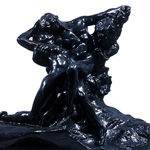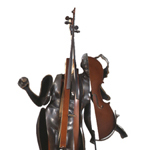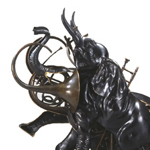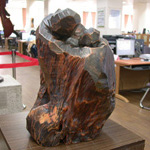
|
Bronze;72x45x36 cm
The ThinkerIn his piece The Thinker, Rodin depicts a man sitting on a rock deep in thought as he gazes down upon humanity. Bent at the waist and wholly absorbed in contemplation, his left hand rests on his left knee while his right arm supports his chin. His brooding appearance of deep pondering symbolizes Rodin’s endless tangle of thoughts, ruminations, and reflections on human life. The sculpture seems to imply that thought is humanity’s only opportunity for redemption while suffering the difficulties and injustices of life.
The Thinker is a vital and powerful man with strong muscles and a robust form. Rodin shows, however, that the value of a person is not in his body but rather in his mind. It is only through enlightened thinking that we have civilization. The humanistic ideology portrayed by Rodin caused The Thinker to become the symbol of 20th century humanity. The sculpture has become a symbol of the depth of human thought that reminds us of the value of life, and can be seen in parks, campuses, library entrances, and plazas across Japan, the U.S., and Europe. Rodin wished for everyone to calm down and think, to devote time to deep and unhurried contemplation. The Thinker is not only a representation of Dante or Rodin but also of each one of us.
|

|
Bronze;67x86x43 cm
Eternal SpringIn 1884, Rodin created a series of sculptures based on the theme of “eternity”. Eternal Spring shows a love-struck couple engaged in a passionate kiss. Both are locked in a tight embrace. The man is leaning down to kiss the woman, while the woman twists upward to greet his kiss with her whole body and soul. The man’s left arm is cast freely in the air like an outstretched wing, while his left leg is raised high in such a way as to appear in the midst of a romantic dance. He seems as though he is on the verge of rising into the air from his sheer delight. His right arm embraces the backward-arching woman whose left arm rests on his shoulder. Although in a semi-kneeling position, she appears held in the man’s embrace, lost in the ecstasy of love.
Rodin met 19-year-old Camille in 1883. Camille was Rodin’s student, model, and lover. Rodin was 43 years old at the time, and this passionate love affair clearly influenced his works. He wished to find an impelling beauty in the theme of eternal human love, and forever embody this beauty through sculpture. From its beginnings in Greece, the Western art of sculpture has evolved around romantic themes, praising the physical and spiritual heights humans can reach through passionate love. Rodin continued this tradition, showing us that for two people in love, life can be as perfect as an eternal spring.
|

|
Bronze;87x51x55 cm
The KissCreated in 1886, the famous sculpture “The Kiss” was inspired by Rodin’s passion for Camille. To enhance the integrated feel of the lovers, the artist gave their lower bodies the appearance of melting into the marble. Carved in a classic realist style, the detailed and elegantly postured forms produce a truly dynamic effect of light and shadow.
Rodin was a 20th century sculptor and is widely considered the progenitor of modern sculpture. Born in Paris, he preferred themes of emotion, movement, and human form in his sculptures. His sculptures in his later years were chiefly inspired by dance. From 1879 to 1882, he worked on a monumental sculptural group called The Gates of Hell, which was meant to be a portal for Paris' planned Museum of Decorative Arts. In The Gates of Hell, Rodin disregarded neat, orderly structures and expressed a type of romanticist-style disorder. Almost 200 figures originally designed for this composition became the basis for some of Rodin’s best-known independent works, such as The Thinker and The Kiss.
|

|
Bronze;136x96x66 cm
Victoire en ChantantVictoire en Chantant was created by the French-American sculptor Arman shortly before his passing. With its elegant, flowing lines, the integration of the woman and the instrument tell of Arman’s lifetime passion, dedication, and achievement in the arts. Victoire en Chantant is a masterpiece into which he invested all of his effort during the last remaining years of his life.
Simultaneously dynamic and contemporary, Victoire en Chantant was based on La Victoire de Samothrace, one of the three treasures of the Louvre. The sculpture is rich in artistic value and historically significant. Arman divided the statute of the goddess and combined it with a cello, thus imbuing classic art with a modern flair. The wings of the goddess, with their finely crafted feathers, are unfurled as she prepares to take flight, and the folds in her robes billow behind her as if fluttering in the wind. The flowing lines express the triumph of victory and the speed of flight. The symbolic meaning of Victoire en Chantant encompass the past, present, and future, showing humanistic spirit and creative power.
|

|
Bronze;150x80x45 cm
Venus au Violocelle boisIn the 1960s, Arman used cleaving and burning methods to deconstruct pianos and string instruments and then re-constitute them into sculptural works. This approach enabled him to express his unique viewpoint on music and artistic creation.
In 1961, Arman produced the Colere series, the media of which was musical instruments. During the filming of a television documentary produced by NBC, Arman smashed a double bass into pieces right in front of the camera and soon thereafter created the now-famous piece NBC Rage. For the Colere de Violoncelles, Arman deconstructed a bronze statute of Venus and then delicately combined the statute with a violin in an interlaced manner to produce a colorfully woven image. The goddess Venus appears to be playing a beautiful, intoxicating melody, and the floating notes are scattered to the air by the deconstructed violin. In Arman’s works, sculptures do not only communicate visual aesthetics but also include auditory effects.
|

|
Bronze;120x55x70 cm
L’elephant Aux InstrumentsIn many ancient civilizations of the Eastern world, elephants have long represented the origins of life. In ancient Indian religion, elephants have even greater mystical meaning. As recorded in UN World Heritage sites, many ancient temples in Cambodia have elephant sculptures in relief. Elephants were the ancient “thrones” of Cambodians. In ancient China, elephants were considered to represent peace and prosperity. Elephants are included in the two rows of stone sculptures leading up to the entryway of the Ming Dynasty palace in Nanjing, China.
In the 1980s, Arman liked to deconstruct bronze statutes of Greek gods and combine them with disassembled musical instruments. Sometimes he would combine these remnants of bronze instruments with deconstructed statutes of animals to form another distinctive type of Arman sculpture. In L’elephant Aux Instruments, Arman again uses cleverly dissected and re-arranged elements to create a visual masterpiece that transforms the original properties of both elephants and musical instruments. The elephant in stride portrays an even more dynamic sense of motion after its deconstruction and re-arrangement, while the instrument introduces an artistic feel. L’elephant Aux Instruments is a perfect depiction of Arman’s unique style of contemporary art.
|

|
Bronze;94x48x62
cmMaternity
Lee Yung-han and Chu Teh-Chun are two of the most outstanding contemporary artists of Chinese descent in France. The sculpture,“Maternity”, was awarded the Silver Medal by the French Artists’ Salon in 1984.
The subject matter of their artwork is predominantly focused on mothers and children. Perhaps this sort of direction enables them to better portray humanity and the growth and continuance of life. The emotion depicted in the mother and daughter along with the breathtaking scenery are meant to express a more beautiful and peaceful side of humanity. The intent of the artists is to use this imagery to cast away the gloom and darkness of the world and evoke the beauty, goodness, and sincerity inherent in the deeper levels of human nature.
|

|
Stout Campho;45x35x30 cmMother and DaughterKang Mu-hsiang is a well-known wood carver from Sanyi Township (a small town in Miaoli County, Taiwan, known almost exclusively for its woodcarving industry), as well as one of the resident artists at Asia University. He has been invited to display his work in many domestic and international exhibitions. The themes of his work are predominantly centered on love and inclusivity. Mr. Kang’s motto is to strive to make his work representative of his character and soul.
The wood carving Mother and Daughter was carved by Kang during a live performance celebrating the 8th anniversary of Asia University. The difference between this work and regular sculptures is that Kang first contemplated the shape and feel of the wood and sought his inspiration from its existing grains and grooves. Within a short amount of time, he produced a natural yet vividly lifelike wood sculpture.
|

